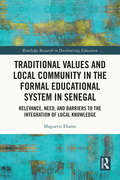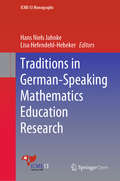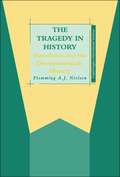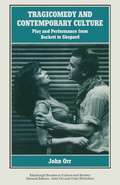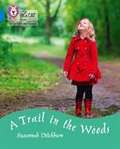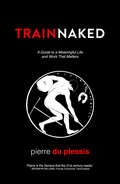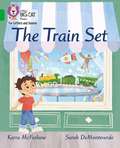- Table View
- List View
Traditional Musics in the Modern World: Transmission, Evolution, and Challenges (Landscapes: the Arts, Aesthetics, and Education #24)
by Bo-Wah LeungThis book reviews the current practices of traditional musics in various cultures of all continents, and examines the impact and significance of traditional musics in the modern world. A diverse group of experts of musicology and music education collaborate to expose the current practices and challenges of transmission and evolution of traditional musics in order to seek sustainable development, so that traditional musics can take the place they deserve in the modern world and continue to contribute to human civilization. This volume contains three main sections that include transmission of traditional musics, authenticity and evolution, as well as challenges in future. Based on the chapters, the editor proposes four major trends of transmission of traditional musics, namely, formalization, politicization, Westernization and modernization in transforming contexts.
A Traditional Quest: Essays in Honour of Louis Jacobs (The Library of Hebrew Bible/Old Testament Studies)
by Dan Cohn-SherbokLouis Jacobs has made a formidable contribution to Jewish scholarship over the last 40 years. In addition he has inspired a generation of students of Judaica as well as members of his own congregation at the New London Synagogue. The contributors to this volume in his honour include a wide range of distinguished scholars. Beginning with Jacob Neusner's essay on the transformation of the Dual Torah in the first four centuries CE, the volume ranges over a variety of topics in the field of Bible, Talmud, history and theology, mirroring the wide range of Louis Jacobs' own interests. In addition, a full bibliography of Louis Jacobs' publications is included.
Traditional Techniques in Classical Hebrew Verse (The Library of Hebrew Bible/Old Testament Studies)
by Wilfred G. WatsonBefore, during and after the preparation of Classical Hebrew Poetry: A Guide to its Techniques, Wilfred Watson published several articles on Hebrew poetry in a wide range of periodicals. The present volume collects together the most significant of these writings, including a chapter from a book on chiasmus, as well as a few unpublished items. After an opening survey of current work on Hebrew verse the articles cover the following topics: parallelism (including half-line parallelism, previously almost unnoticed), antithesis, word pairs, chiasmus, figurative language and introductions to speech in verse. The last section deals with structural devices and a folktale motif in narrative verse, hyperbole, apostrophe and alliteration. Previously unpublished items are on the contribution of ethnopoetics, from the study of Native American literature to Hebrew narrative verse (a new topic in biblical studies), parallelism in the Song of Songs and a metaphor in Jeremiah. This anthology is intended as a companion volume to Classical Hebrew Poetry. It includes additions and corrections to that book and there are also several indices.
Traditional Values and Local Community in the Formal Educational System in Senegal: Relevance, Need, and Barriers to the Integration of Local Knowledge (Routledge Research in Decolonizing Education)
by Maguette DiameThis book explores the discourse of traditional values and local practices within the formal educational system in Senegal, investigating how these cultural elements are present in the daily life of the community and integrated into formal schools and teaching. Studying the integration of concepts such as Jom (hard work, pride, dignity), Kersa (decency), Fule (self-respect), Mun (endurance), Teranga (hospitality), Kal (kinship), and Suture (Protection), it looks at how values are used, perceived and understood within communities, as well as their positive and negative connotations in the postcolonial context. Based on long-term participant education and utilizing a critical auto-ethnography lens, it ultimately proposes that such concepts can be used to counterbalance the Western knowledge to which schoolchildren are mostly exposed, connecting this to Bhaba’s system of the ‘Third Space”; a hybrid system to accommodate both educational systems for more relevant education. An informed study of the positive impacts of traditional cultural values on education in Senegal, it will appeal to scholars, researchers and practitioners of education in post-colonial Francophone countries with interests in culturally relevant education, African education, post-colonial education, and international education.
Traditional Values and Local Community in the Formal Educational System in Senegal: Relevance, Need, and Barriers to the Integration of Local Knowledge (Routledge Research in Decolonizing Education)
by Maguette DiameThis book explores the discourse of traditional values and local practices within the formal educational system in Senegal, investigating how these cultural elements are present in the daily life of the community and integrated into formal schools and teaching. Studying the integration of concepts such as Jom (hard work, pride, dignity), Kersa (decency), Fule (self-respect), Mun (endurance), Teranga (hospitality), Kal (kinship), and Suture (Protection), it looks at how values are used, perceived and understood within communities, as well as their positive and negative connotations in the postcolonial context. Based on long-term participant education and utilizing a critical auto-ethnography lens, it ultimately proposes that such concepts can be used to counterbalance the Western knowledge to which schoolchildren are mostly exposed, connecting this to Bhaba’s system of the ‘Third Space”; a hybrid system to accommodate both educational systems for more relevant education. An informed study of the positive impacts of traditional cultural values on education in Senegal, it will appeal to scholars, researchers and practitioners of education in post-colonial Francophone countries with interests in culturally relevant education, African education, post-colonial education, and international education.
Traditions at Odds: The Reception of the Pentateuch in Biblical and Second Temple Period Literature (The Library of Hebrew Bible/Old Testament Studies)
by John H. ChoiTraditions at Odds explores the Pentateuch's literary influence on other biblical texts. There exist a number of content discrepancies between pentateuchal and non-pentateuchal texts that treat the same subject. Through a detailed analysis, the author argues that the discrepancies are not alterations of pentateuchal material, as is generally argued, but rather indications of independent traditions. Thus, much of biblical literature was written outside of the Pentateuch's purview. Corroborating evidence is found in literature from the Second Temple Period, which also exhibits a lack of conformity to the Pentateuch. After demonstrating this independence, this study explores its implications on the composition of biblical texts and the process of canonization. Marked by an interdisciplinary approach, the study incorporates recent theoretical developments in literary and ideological criticism, as well as ritual, historiography and textual citation. It not only provides a broader base of study, but serves to address a deficiency in biblical studies: most studies of intertextuality operate with little theoretical grounding, while studies in ritual or historiography are based on models from the late 19th/early 20th centuries.
Traditions in German-Speaking Mathematics Education Research (ICME-13 Monographs)
by Hans Niels Jahnke Lisa Hefendehl-HebekerThis open access book shares revealing insights into the development of mathematics education research in Germany from 1976 (ICME 3 in Karlsruhe) to 2016 (ICME 13 in Hamburg). How did mathematics education research evolve in the course of these four decades? Which ideas and people were most influential, and how did German research interact with the international community? These questions are answered by scholars from a range of fields and in ten thematic sections: (1) a short survey of the development of educational research on mathematics in German speaking countries (2) subject-matter didactics, (3) design science and design research, (4) modelling, (5) mathematics and Bildung 1810 to 1850, (6) Allgemeinbildung, Mathematical Literacy, and Competence Orientation (7) theory traditions, (8) classroom studies, (9) educational research and (10) large-scale studies. During the time span presented here, profound changes took place in German-speaking mathematics education research. Besides the traditional fields of activity like subject-matter didactics or design science, completely new areas also emerged, which are characterized by various empirical approaches and a closer connection to psychology, sociology, epistemology and general education research. Each chapter presents a respective area of mathematics education in Germany and analyzes its relevance for the development of the research community, not only with regard to research findings and methods but also in terms of interaction with the educational system. One of the central aspects in all chapters concerns the constant efforts to find common ground between mathematics and education. In addition, readers can benefit from this analysis by comparing the development shown here with the mathematical education research situation in their own country.
Traffic Safety and Human Behavior: Second Edition
by David ShinarTraffic crashes are one of the ten leading causes of deaths worldwide, and the leading cause of death for young people in the western world - a seemingly necessary evil that accompanies increasing levels of motorization. In this comprehensive 2nd edition of the classic “Traffic Safety and Human Behavior” Dr David Shinar provides a theoretical framework and a critical evaluation of the most recent research findings to comprehend the complexity of traffic safety and the central role that road users - drivers, motorcyclists, bicyclists, and pedestrians play in it. In the new edition of approximately 1000 pages with nearly 300 graphs and tables, Shinar covers the key issues that relate human behavior to traffic safety and the impact that cultural, policy, and technological changes have on them. In particular the new edition covers the increasing roles that pedestrians and cyclists have in the traffic system and the need to accommodate them; the intrusion of infotainment and its role in driver distraction; and the increasing role of crash-prevention and driver assistance systems in changing the driver-vehicle interaction.
Traffic Safety and Human Behavior: Second Edition
by David ShinarTraffic crashes are one of the ten leading causes of deaths worldwide, and the leading cause of death for young people in the western world - a seemingly necessary evil that accompanies increasing levels of motorization. In this comprehensive 2nd edition of the classic “Traffic Safety and Human Behavior” Dr David Shinar provides a theoretical framework and a critical evaluation of the most recent research findings to comprehend the complexity of traffic safety and the central role that road users - drivers, motorcyclists, bicyclists, and pedestrians play in it. In the new edition of approximately 1000 pages with nearly 300 graphs and tables, Shinar covers the key issues that relate human behavior to traffic safety and the impact that cultural, policy, and technological changes have on them. In particular the new edition covers the increasing roles that pedestrians and cyclists have in the traffic system and the need to accommodate them; the intrusion of infotainment and its role in driver distraction; and the increasing role of crash-prevention and driver assistance systems in changing the driver-vehicle interaction.
Traffic Safety Culture: Definition, Foundation, and Application
by Nicholas John Ward Barry Watson Katie Fleming-VoglThis reference book provides traffic safety researchers and practitioners with an international and multi-disciplinary compendium of theoretical and methodological chapters. Together, these chapters discuss the research and application of “Traffic Safety Culture” as an important approach to traffic safety, including the vision of zero traffic fatalities and serious injuries. Traffic crashes are a significant cause of death and debilitating injury worldwide, especially in low- and middle-income countries. Whereas most traditional safety efforts teach safe behavior (education), punish risky behavior (enforcement), or design the environment to minimize crash injury resulting from those behaviors (engineering), there is also the need to understand the culture of our social environments that influence our concern for traffic safety and choice of behaviors. As a result, there is growing interest in the concept of Traffic Safety Culture. However, this concept is relatively new and is not yet supported by a robust theoretical foundation or amassed large body of research. The goal of this book is to create a theoretical foundation and methodological framework for using traffic safety culture, including the discussion of best practices for developing, implementing and evaluating culture-based strategies.
Traffic Safety Culture: Definition, Foundation, and Application
by Nicholas John Ward Barry Watson Katie Fleming-VoglThis reference book provides traffic safety researchers and practitioners with an international and multi-disciplinary compendium of theoretical and methodological chapters. Together, these chapters discuss the research and application of “Traffic Safety Culture” as an important approach to traffic safety, including the vision of zero traffic fatalities and serious injuries. Traffic crashes are a significant cause of death and debilitating injury worldwide, especially in low- and middle-income countries. Whereas most traditional safety efforts teach safe behavior (education), punish risky behavior (enforcement), or design the environment to minimize crash injury resulting from those behaviors (engineering), there is also the need to understand the culture of our social environments that influence our concern for traffic safety and choice of behaviors. As a result, there is growing interest in the concept of Traffic Safety Culture. However, this concept is relatively new and is not yet supported by a robust theoretical foundation or amassed large body of research. The goal of this book is to create a theoretical foundation and methodological framework for using traffic safety culture, including the discussion of best practices for developing, implementing and evaluating culture-based strategies.
Trafficking and Prostitution Reconsidered: New Perspectives on Migration, Sex Work, and Human Rights
by Kamala KempadooTrafficking and prostitution are widely believed to be synonymous, and to be leading international crimes. This collection argues against such sensationalism and advances carefully considered and grounded alternatives for understanding transnational migrations, forced labor, sex work, and livelihood strategies under new forms of globalization. From their long-term engagements as anti-trafficking advocates, the authors unpack the contemporary international debate on trafficking. They maintain that rather than a new 'white slave trade,' we are witnessing today, more broadly, an increase in the violation of the rights of freedom of movement, decent employment, and social and economic security. Critical examinations of state anti-trafficking interventions, including the U.S.- led War on Trafficking, also reveal links to a broader attack on undocumented migrants; tribal and aboriginal peoples; poor women, men, and children; and sex workers. The book sheds new light on everyday circumstances, popular discourses, and strategies for survival under twenty-first century economic and political conditions, with a focus on Asia, but with lessons globally. Contributors: Natasha Ahmad, Vachararutai Boontinand, Lin Chew, Melissa Ditmore, John Frederick, Matthew S. Friedman, Josephine Ho, Jagori, Ratna Kapur, Phil Marshall, Jyoti Sanghera, Susu Thatun.
Trafficking and Prostitution Reconsidered: New Perspectives on Migration, Sex Work, and Human Rights
by Kamala KempadooTrafficking and prostitution are widely believed to be synonymous, and to be leading international crimes. This collection argues against such sensationalism and advances carefully considered and grounded alternatives for understanding transnational migrations, forced labor, sex work, and livelihood strategies under new forms of globalization. From their long-term engagements as anti-trafficking advocates, the authors unpack the contemporary international debate on trafficking. They maintain that rather than a new 'white slave trade,' we are witnessing today, more broadly, an increase in the violation of the rights of freedom of movement, decent employment, and social and economic security. Critical examinations of state anti-trafficking interventions, including the U.S.- led War on Trafficking, also reveal links to a broader attack on undocumented migrants; tribal and aboriginal peoples; poor women, men, and children; and sex workers. The book sheds new light on everyday circumstances, popular discourses, and strategies for survival under twenty-first century economic and political conditions, with a focus on Asia, but with lessons globally. Contributors: Natasha Ahmad, Vachararutai Boontinand, Lin Chew, Melissa Ditmore, John Frederick, Matthew S. Friedman, Josephine Ho, Jagori, Ratna Kapur, Phil Marshall, Jyoti Sanghera, Susu Thatun.
Trafficking Hadassah: Collective Trauma, Cultural Memory, and Identity in the Book of Esther and in the African Diaspora (Rape Culture, Religion and the Bible)
by Ericka Shawndricka DunbarThe representation of sexual trafficking in the book of Esther has parallels with the cultural memories, histories, and materialized pain of African(a) girls and women across time and space, from the Persian Empire, to subsequent slave trade routes and beyond. Trafficking Hadassah illuminates that Africana female bodies have been and continue to be colonized and sexualized, exploited for profit and pleasure, causing adverse physical, mental, sexual, socio-cultural, and spiritual consequences for the girls and women concerned. It focuses on sexual trafficking both in the biblical book of Esther and during the transatlantic slave trade to demonstrate how gender and racism intersect with other forms of oppression, including legal oppression, which results in the sexual trafficking of African(a) females. It examines both the conditions and mechanisms by which the trafficking of the virgin girls (who are collectively identified) are legitimated and normalized in the book of Esther, alongside contemporary histories of Africana females. This important book examines ideologies and stereotypes that are used to justify the abuse in both contexts, challenges the complicity of biblical readers and interpreters in violence against girls and women, and illustrates how attention to the nameless, faceless African girls in the text is impacted by the #MeToo and #SayHerName social movements. This book will be of particular interest to those studying the Bible, religion, gender, theology, and sex trafficking. It is also an important book for those in the related fields of Africana Studies, Trauma Studies, Post-Colonial Studies, Diaspora Studies, Critical Race Studies, as well as to the general reader.
Trafficking Hadassah: Collective Trauma, Cultural Memory, and Identity in the Book of Esther and in the African Diaspora (Rape Culture, Religion and the Bible)
by Ericka Shawndricka DunbarThe representation of sexual trafficking in the book of Esther has parallels with the cultural memories, histories, and materialized pain of African(a) girls and women across time and space, from the Persian Empire, to subsequent slave trade routes and beyond. Trafficking Hadassah illuminates that Africana female bodies have been and continue to be colonized and sexualized, exploited for profit and pleasure, causing adverse physical, mental, sexual, socio-cultural, and spiritual consequences for the girls and women concerned. It focuses on sexual trafficking both in the biblical book of Esther and during the transatlantic slave trade to demonstrate how gender and racism intersect with other forms of oppression, including legal oppression, which results in the sexual trafficking of African(a) females. It examines both the conditions and mechanisms by which the trafficking of the virgin girls (who are collectively identified) are legitimated and normalized in the book of Esther, alongside contemporary histories of Africana females. This important book examines ideologies and stereotypes that are used to justify the abuse in both contexts, challenges the complicity of biblical readers and interpreters in violence against girls and women, and illustrates how attention to the nameless, faceless African girls in the text is impacted by the #MeToo and #SayHerName social movements. This book will be of particular interest to those studying the Bible, religion, gender, theology, and sex trafficking. It is also an important book for those in the related fields of Africana Studies, Trauma Studies, Post-Colonial Studies, Diaspora Studies, Critical Race Studies, as well as to the general reader.
The Tragedy in History: Herodotus and the Deuteronomistic History (The Library of Hebrew Bible/Old Testament Studies)
by Flemming A. NielsenIn this challenging new work, Nielsen compares Herodotus with Old Testament historiography as represented by the so-called Deuteronomistic History. He finds in the Old Testament evidence of a tragic form like that encountered in Herodotus's Histories. Nielsen begins by outlining Herodotus's Greek context with its roots in Ionic natural philosophy, the epic tradition and Attic tragedy, and goes on to analyse in some detail the outworking of the Herodotean tragedy. Against that background, the Deuteronomistic History is to be viewed as an ancient Near Eastern historiographic text in the tragic tradition.
Tragedy in the Gulf: A Call for a New Engineering Ethic (Synthesis Lectures on Engineers, Technology, & Society)
by George CatalanoThe recent tragedy in the Gulf of Mexico and resultant ethical consequences for the engineering profession are introduced and discussed. The need for a new engineering ethic is identified and introduced based upon advancements in science, complex systems and eco-philosophy. Motivations for introducing a new ethic rather than modifying existing ethics are also discussed. Table of Contents: Tragedy in the Gulf / Tragedy Unfolding / Engineering Ethics / Complex Systems / Quantum Mechanics / Evolving Principles of the Universe / A New Engineering Ethic / Epilogue
The Tragedy of American School Reform: How Curriculum Politics and Entrenched Dilemmas Have Diverted Us from Democracy
by Ronald W. EvansTwo persistent dilemmas haunt school reform: curriculum politics and classroom constancy. Both undermined the 1960s' new social studies, a dynamic reform movement centered on inquiry, issues, and social activism. Dramatic academic freedom controversies ended reform and led to a conservative restoration. On one side were teachers and curriculum developers; on the other, conservative activists determined to undo the revolutions of the 1960s. The episode brought a return to traditional history, a turn away from questioning, and the re-imposition of authority. Engagingly written and thoroughly researched, The Tragedy of American School Reform offers a provocative perspective on current trends.
Tragicomedy and Contemporary Culture: Play and Performance from Beckett to Shepard (Edinburgh Studies in Culture and Society)
by John OrrThis study examines the historical relationship between tragicomedy in the modernist theatre and the performative culture of Western consumer societies. While discussing a wide range of playwrights, it focusses specifically on the work of Samuel Beckett, Harold Pinter and Sam Shepard. Their plays, it is argued, illuminate the forms of pleasure, fear, performance and corruption which dominate our daily lives. Tragicomedy is seen as unique becuae of the existential playfulness and confusion of its protagonists, and because of its muted vision of apocalypse in the nuclear age.
A Trail in the Woods: Band 4 Blue (PDF) (Collins Big Cat Phonics For Letters And Sounds Ser.)
by Suzannah DitchburnCollins Big Cat Phonics for Letters and Sounds features exciting fiction and non-fiction decodable readers to enthuse and inspire children. They are fully aligned to Letters and Sounds Phases 1-6 and contain notes in the back. The Handbooks provide support in demonstration and modelling, monitoring comprehension and expanding vocabulary. Find out all the different things you can do and see when you got on a trail in the woods in this non-fiction book. Blue/Band 4 books offer longer, repeated patterns with sequential events and integrated literary and natural language. This book focuses on adjacent consonants with long vowel phonemes. Pages 14 and 15 allow children to re-visit the content of the book, supporting comprehension skills, vocabulary development and recall. Reading notes within the book provide practical support for reading Big Cat Phonics for Letters and Sounds with children, including a list of all the sounds and words that the book will cover.
Trailblazers for Whole School Sustainability: Case Studies of Educators in Action
by Cynthia Merse Jennifer Seydel Lisa Kensler David SobelWhat does it take to prepare students, teachers, and school staff to shape a just and sustainable future? In Trailblazers for Whole School Sustainability, you will meet educators and school leaders who are on the front lines of re-imagining school through the lens of sustainability. This book features inspiring stories from around the country, from urban and rural schools and districts, that highlight best practices and lessons learned from teachers, administrators, and students as they transformed their school communities for a just and sustainable future. These stories are structured around a practical framework that demonstrates how this work allows schools and districts to work smarter, not harder, by integrating sustainability and systems thinking into leadership; curriculum and instruction; culture and climate; and facilities and operations. While each school and district’s story in this book is different, the passion that drives each one to embrace sustainability in everything they do, from operations to curriculum, remains the same. Trailblazers for Whole School Sustainability shows what is possible when educators resolve to blaze a trail to re-imagine K-12 education for a just and sustainable future.
Trailblazers for Whole School Sustainability: Case Studies of Educators in Action
by Jennifer SeydelWhat does it take to prepare students, teachers, and school staff to shape a just and sustainable future? In Trailblazers for Whole School Sustainability, you will meet educators and school leaders who are on the front lines of re-imagining school through the lens of sustainability. This book features inspiring stories from around the country, from urban and rural schools and districts, that highlight best practices and lessons learned from teachers, administrators, and students as they transformed their school communities for a just and sustainable future. These stories are structured around a practical framework that demonstrates how this work allows schools and districts to work smarter, not harder, by integrating sustainability and systems thinking into leadership; curriculum and instruction; culture and climate; and facilities and operations. While each school and district’s story in this book is different, the passion that drives each one to embrace sustainability in everything they do, from operations to curriculum, remains the same. Trailblazers for Whole School Sustainability shows what is possible when educators resolve to blaze a trail to re-imagine K-12 education for a just and sustainable future.
Train Naked: A Guide to a Meaningful Life and Work That Matters
by Pierre du PlessisThe ancient Greeks trained in the nude in the gymnasium and also competed in the buff in the Olympic Games. They literally had skin in the game. The ancient Greek word for gymnasium, gumnasia, means to train naked. However, the ancient Greek gyms were not just for physical training but also had dedicated spaces for intellectual exercise, for philosophy, teaching and conversation.To train naked is to show up just as you are. No pretences, no masks, no BS. We train to compete, we practise in order to nail a presentation. We should also be training to become better human beings, to craft meaningful lives, do work that matters, and to thrive in chaos. Pierre du Plessis’s daily reflections, meditations and practices presented in this book are a call to train naked, to practise for the ultimate marathon, and to have skin in the game.Train Naked is a curated selection of short reflections, prompts to get skin in the game, on building a meaningful life and doing work that matters. Combined with a selection of ancient practices, such as meditation, Pierre’s thoughts and ideas aim to inspire each reader to take charge, to try, to act, to learn and to do. Get skin in the game.
The Train Set: Band 05/green (Collins Big Cat Phonics For Letters And Sounds Ser.)
by Karra McFarlane Sarah DeMonteverde Collins Big CatCollins Big Cat Phonics for Letters and Sounds features exciting fiction and non-fiction decodable readers to enthuse and inspire children. They are fully aligned to Letters and Sounds Phases 1–6 and contain notes in the back. The Handbooks provide support in demonstration and modelling, monitoring comprehension and expanding vocabulary. Alex sees an amazing train set in a shop window, but it's too expensive. Alex has a plan! Can he and his Dad make a train better than the one in the shop? Green/Band 5 offers early readers patterned language and varied characters. The focus sounds in this book are: /ai/ ay, ey, a-e Pages 22 and 23 allow children to re-visit the content of the book, supporting comprehension skills, vocabulary development and recall. Reading notes within the book provide practical support for reading Big Cat Phonics for Letters and Sounds with children, including a list of all the sounds and words that the book will cover.
Train the Trainer: Unlock your potential as a professional trainer
by Eleanor O'CarrollEssential guide for those who wish to unlock their potential as a professional trainer. Learn how to develop your confidence, conquer your fear of public speaking and refine your skills.Train the Trainer gives guidance on each stage of the Training Cycle, i.e. identifying training needs, designing training, delivering training and evaluating training; presents good training practice; explains the importance and relevance of different kinds of learning, including experiential and task-based learning; encourages reflective practice and continuous professional development; describes how to identify training needs, devise learning objectives and prepare and plan appropriate training methods to achieve those objectives; outlines how to plan, prepare and deliver a dynamic and thought-provoking presentation using a variety of resources.The book contains a completed sample training needs analysis (TNA) document and provides instruction on how to develop and implement appropriate assessment and evaluation methods.The appendices include a quick Inventory of Activities that is useful for Group Training Scenarios and ideas for Activities for Train the Trainer Course Tutors to use on courses.Ideal for all those involved in professional training and for students on Train the Trainer courses.



